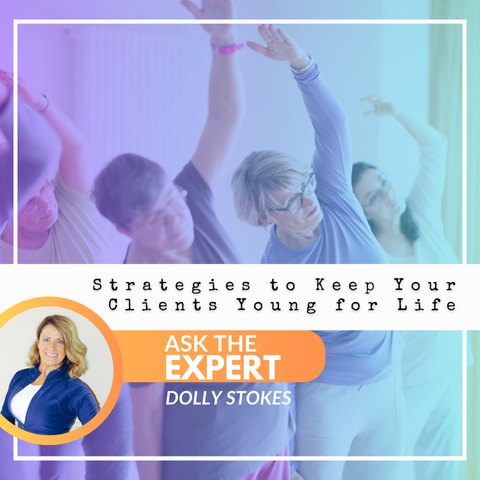Enviado por Melissa Vidito el

By Dolly Stokes, FiTOUR®
Due to the natural aging process, the central nervous system (CNS) experiences nerve loss, loss of neurons and diminished brain size.
In relation to physical function, changes can manifest as slowed reflexes or a reduction in sensation, both of which can lead to dysfunctional movement. Changes can also affect one’s ability to process information as well as memory. Other age-related changes include diminished vision and hearing, both of which can negatively affect balance and proprioception.
While natural aging of the CNS cannot be fully extinguished, it can be diminished through the practice of exercises that stimulate neuroplasticity along with exercises that stimulate proprioceptors and the vestibular system.
We may see an age-related change when, overtime, a client begins to experience a shorter attention span. This, in itself, can result in distracted and disjointed movement. While it may be tempting to avoid complex exercises with a client who suffers from a short attention span, it is important to include activities that require focus, concentration and control. Rather than sticking with simple skill exercises during a training session, include complex movements that may need to be “re-learned” over the course of several training sessions to elicit concentration and focus which, in turn, will enhance neuroplasticity.
A good example of a simple skill exercise which does not require focus is standing bilateral biceps curls with both feet under the hips. A more complex version that will help to develop proprioception, balance, and coordination would be to perform biceps curls while simultaneously performing alternating rear lunges. With a complex exercise such as this a client may not be able to recall exactly how to perform the exercise with good coordination and may need to “re-learn” the exercise throughout multiple training sessions.
Once the client has mastered the exercise, you may then add progressions such as unilateral biceps curls, one-leg balancing, with a progression to including an elevated or unstable surface.
It is important to keep safety in the forefront when selecting exercises and including progressions: (1) Teach the basic skill first; and (2) Never progress until the client has mastered a skill.
Following is a sample of basic progressions for the combination biceps curls with alternating rear lunges exercise.
-
Teach proper form for bilateral biceps curls.
-
Teach proper form for alternating rear lunges.
-
Combine the bilateral curls with alternating rear lunges.
-
Teach a static leg lunge on both sides.
-
When the client is able to demonstrate good balance and control in the static single leg lunge, add bilateral biceps curls while performing the single leg static lunge.
-
Once this is accomplished, progress to alternating lunges with unilateral biceps curls.
-
Progress to single leg static lunge with right leg while performing unilateral curl with left arm, then perform static lunge with left leg while performing unilateral curl with right arm.
-
Over time, you may elect to add an elevated surface such as a step or an unstable surface such as BOSU.
For more information on how to keep your clients young and healthy, the FiTOUR® Active Aging Primary and Advancedcourses will provide tools to create progressive, safe and effective programming including neuroplasticity, balance, and proprioception specific training.
Dolly Stokes has been a certified professional fitness trainer for over 30 years, has been a FiTOUR® ProTrainer for over 20 years, and has authored 14 FiTOUR® courses including the Active Aging Primary and Advanced courses. Dolly and her husband, Jeff, own Stokes Method Studio in Fairhope, AL where Dolly specializes in functional and corrective exercise.
